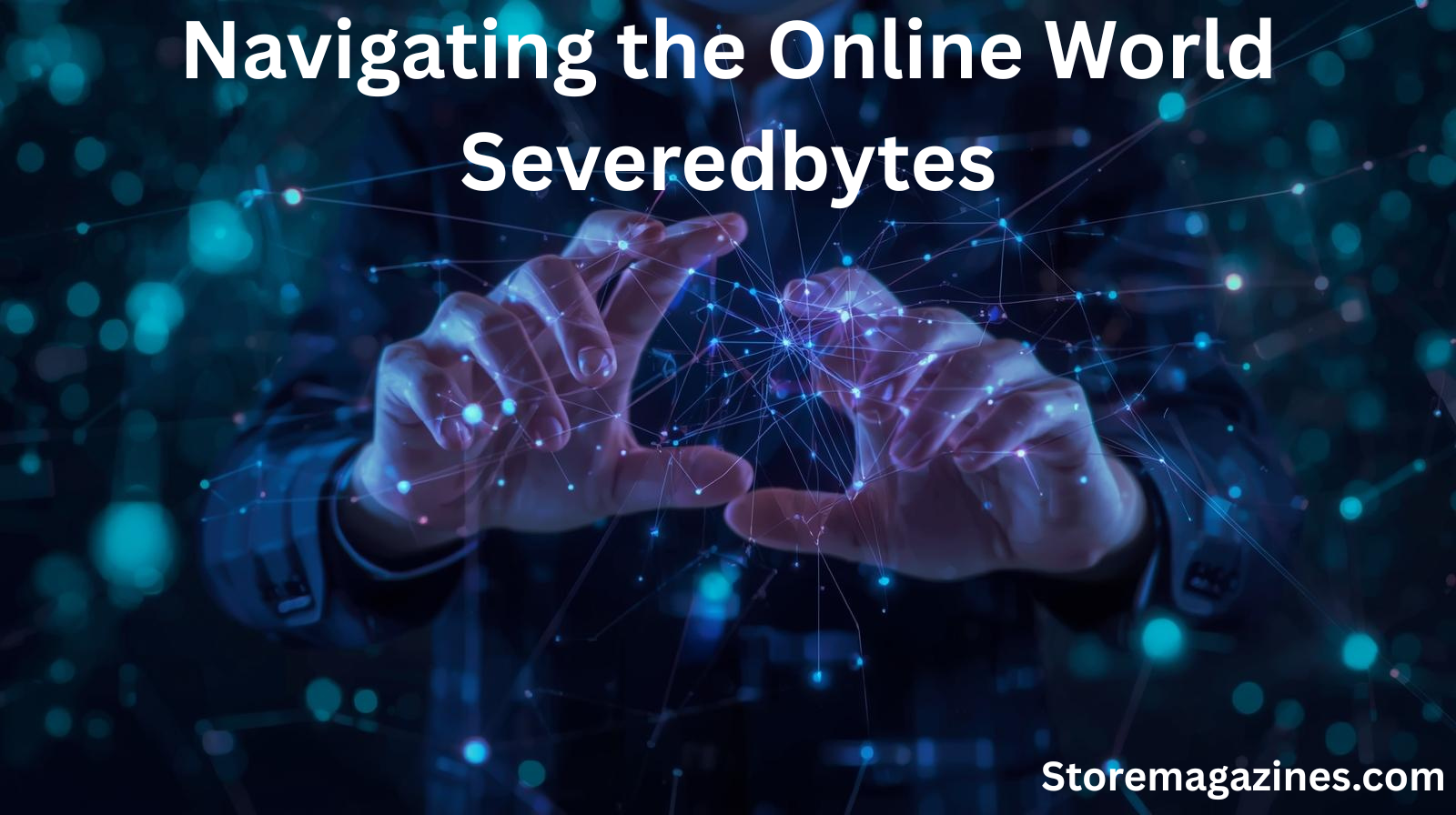We pour so much of our lives into the digital realm. Our photos live on social media, our professional networks are built on platforms like LinkedIn, and our deepest thoughts are chronicled in blogs or forum posts. We operate under the assumption that this digital extension of ourselves is permanent, a concrete archive of our existence. But what happens when parts of that world disappear? A favorite blog you’ve followed for years vanishes.
A gaming server where you spent hundreds of hours building communities and friendships is shut down without warning. A forum that was a lifeline during a difficult time closes, taking all its history with it. This is the reality of “Online Severedbytes”—the fragmented, lost, and disconnected pieces of our digital lives and culture. These are the digital ghosts, the 404 errors, and the “content no longer available” messages that haunt the internet, representing a growing crisis of digital impermanence.
I remember this feeling all too well. Years ago, I was part of a small, niche online community dedicated to a specific type of creative writing. It wasn’t a huge platform, but it was our platform. We shared work, gave feedback, and formed genuine friendships. One morning, I tried to log in, and the site was gone. No warning, no explanation. Just an error page.
The domain had expired, the owner was unreachable, and years of collective creativity, conversation, and connection were wiped out in an instant. That experience taught me a hard lesson: the digital world we build is often on rented land, and the landlord can evict us at any moment. This personal encounter with severedbytes is what drove me to understand the phenomenon better—not just as a technical issue, but as a deeply human one that affects our memory, our communities, and our sense of self.
What Exactly Are Online Severedbytes?
Before we dive deeper, it’s important to establish a clear understanding of the term. “Online Severedbytes” refers to any digital content, community, or data that has been abruptly and permanently disconnected from the public internet, leaving behind a void. This isn’t just about a website being down for maintenance. It’s about the permanent loss of digital artifacts. Think of it as the digital equivalent of a lost city or a library that has burned to the ground.
These fragments represent more than just lost data; they are severed pieces of our collective culture and personal histories. The phenomenon encompasses everything from defunct social media platforms like Vine, which housed countless moments of creative genius, to personal blogs that served as intimate diaries, to the shutdown of multiplayer game servers that were once thriving virtual societies. Each severed byte is a broken link in the chain of our shared digital experience, a ghost in the machine that reminds us of the fragility of our online world.
The term itself, “Severedbytes,” paints a vivid picture. “Severed” implies a forceful, often sudden separation, while “bytes” points to the fundamental units of digital information. Together, they describe the act of digital information being cut off from its source or its network, leaving it orphaned and inaccessible. This can happen for a multitude of reasons, from corporate decisions to personal choice or simple neglect.
The result, however, is always the same: a piece of the internet’s vast tapestry is torn away, and the context, knowledge, and community attached to it are often lost forever. Understanding this concept is the first step toward recognizing the scale of the problem and exploring ways to preserve our digital heritage before more of it slips away into the digital void.
The Anatomy of Digital Disappearance: How Content Gets Severed
Digital content doesn’t just vanish into thin air. Its disappearance is usually the result of specific actions or inactions. Understanding the causes can help us appreciate the different forces at play that contribute to the growing landscape of severedbytes. I’ve seen these play out time and again, and they generally fall into a few key categories.
One of the most common culprits is what I call the “Commercial Sunset.” This occurs when a company decides that a service, platform, or feature is no longer financially viable. Think of Google Reader, a beloved RSS feed aggregator that was shut down despite its loyal user base, or the countless online games whose servers are unplugged once they stop turning a sufficient profit.
In these cases, the data isn’t necessarily destroyed right away, but it’s walled off from the public, effectively severing it from the living web. The decision is rarely malicious; it’s a business calculation. But for the users who invested their time and created content on these platforms, the result is a form of digital eviction.
Another significant cause is the “Personal Purge.” This is when an individual creator, artist, or writer decides to delete their own digital footprint. This can be due to burnout from the pressures of maintaining an online presence, harassment, a desire for privacy, or simply a change in life direction.
I’ve known several bloggers who, after years of sharing their lives, decided to scrub their entire archives to move on to a new chapter. While this is a creator’s right, it contributes to the loss of unique voices and stories from the internet’s history. It’s a conscious uncoupling from a digital identity, but it leaves a hole where valuable content once was.
Finally, there’s the slow, creeping death by “Digital Decay and Neglect.” This is the most insidious cause of severed bytes because it often happens silently, without a grand announcement.
- Link Rot: This is the process where hyperlinks, over time, stop pointing to their source. A study once found that over 50% of URLs cited in Supreme Court opinions no longer linked to the original information. This erodes the foundation of knowledge, creating articles and research that are full of dead ends.
- Domain & Hosting Expiration: Many websites are run by individuals or small groups. If a domain name isn’t renewed or a web hosting bill goes unpaid, the site disappears. My old writing community likely met this fate. It’s death by neglect, often accidental but just as final.
- Technological Obsolescence: Content built on old technology, like Adobe Flash, becomes inaccessible as modern browsers cease to support it. Entire archives of games, animations, and interactive art from the early 2000s are now largely unviewable, severed by the forward march of technology.
The Human Cost of Losing Our Digital History
The loss of online content might seem trivial to some—just a bunch of old memes, forgotten blogs, and dead links. But the impact of severed bytes goes much deeper, touching upon our culture, our communities, and our psychology. When a digital space disappears, it’s not just data that is lost; it’s the human experience connected to that data. We are losing primary sources of our recent history, and the consequences are more profound than we might realize.
The most significant impact is the erosion of our collective cultural memory. The early internet was a chaotic, creative, and wonderfully weird place. It was the primordial soup from which modern digital culture—memes, vlogs, online communities, and social media—emerged. Much of this foundational content, from the quirky homepages on GeoCities to the first viral videos on long-forgotten platforms, is now gone.
Future historians and sociologists will have a massive blind spot when trying to understand the birth of the digital age. It’s like trying to study the Renaissance with only half the paintings and none of the artists’ letters. We are failing to preserve the artifacts of our own time, and this loss of cultural heritage is happening on a scale we have yet to comprehend fully.
Beyond the cultural loss, there is a deep personal and psychological cost. For many people, especially those in marginalized groups or with niche interests, online forums and communities were not just a pastime; they were essential lifelines. A message board for individuals with a rare disease, a fanfiction archive that provided a safe space for LGBTQ+ youth, or a forum for a hobby that was misunderstood in the “real world”—these were places of belonging.
When such a community is severed, it’s a form of digital trauma. It’s a forced displacement from a home that you helped build. I’ve spoken with people who still mourn the loss of online communities from a decade ago, not because of the content itself, but because of the friendships and sense of identity they lost when the server was shut down. Our digital identities are becoming increasingly intertwined with these platforms, yet their ephemeral nature makes that identity incredibly fragile.
SeveredBytes in Gaming: The Loss of Virtual Worlds
The world of online gaming is one of the most poignant examples of the severed bytes phenomenon. Unlike a static webpage, a persistent online game world is a living, breathing ecosystem. Players invest thousands of hours and form deep social bonds within these virtual spaces. They build empires, go on epic quests with friends, and create entire societies with their own economies and politics. When a developer decides to shut down a game’s servers, it’s not just a game that ends; an entire world dies.
I vividly remember the shutdown of Star Wars Galaxies. Before its “New Game Enhancement” overhaul and eventual closure, it was a sandbox masterpiece. You didn’t have to be a Jedi; you could be a cantina owner, a creature handler, a master artisan, or a politician. Players built entire cities, ran their own businesses, and created stories that were never part of the developer’s script. When the servers went dark, all of that was erased.
The player-built cities, the unique items crafted by master artisans, the history of player-run governments—all gone. It was a cultural extinction event for a community of hundreds of thousands. While some dedicated fans have since created private “emulator” servers to resurrect the classic game, the original universe and its history are severed forever.
This issue highlights a fundamental conflict in online gaming: players invest their time and creativity, but the corporation holds all the keys. The user agreement almost always states that you are merely licensing the right to play, and that the company can revoke that access at any time. This creates a powerful emotional disconnect. Players feel a sense of ownership over their characters and their virtual property, yet legally, they own nothing.
The shutdown of an online game is a stark reminder of this power imbalance. It is a mass severance of bytes that affects millions of players worldwide each year, leaving behind a trail of digital ghost towns and heartbroken communities who have lost their virtual homes.
The Challenge of Digital Preservation
If the problem is that our digital world is disappearing, the obvious solution is to save it. However, digital preservation is a monumental task, fraught with technical, legal, and ethical challenges. It’s not as simple as backing up a file to a hard drive. The very nature of the internet—its interconnectedness, its dynamism, and its sheer scale—makes preservation incredibly difficult.
The first major hurdle is technical. A modern website is not a self-contained document. It’s a complex web of code, databases, scripts, and links to external resources. To truly preserve a site, you need to capture all these elements in a way that allows them to function. This is why projects like the Internet Archive’s Wayback Machine are so vital.
They use web crawlers to take “snapshots” of websites at different points in time. But even this amazing tool has its limits. It can’t capture content behind paywalls or login screens, it struggles with highly dynamic or interactive content, and it can’t preserve the community interactions that give a site its soul. Preserving a forum isn’t just about saving the text of the posts; it’s about the context of the conversation, which is much harder to archive.
Then there are the legal and ethical quandaries. Who has the right to archive content? The vast majority of content on the internet is copyrighted. While preservation for archival and educational purposes often falls under “fair use,” the legal ground can be shaky, especially when a company or individual does not want their content saved.
There are also privacy concerns. Should personal information shared on a forum be preserved forever in a public archive, even if the original poster later regrets sharing it? Navigating the balance between preserving culture and respecting individual privacy and ownership rights is one of the most difficult challenges for digital archivists. It requires a thoughtful approach that prioritizes both our collective memory and personal autonomy.
Strategies for Personal Digital Stewardship
While large-scale preservation projects are essential, the fight against severedbytes also begins with us. We can’t rely on corporations or even non-profits to save everything we care about. We must become active stewards of our own digital lives and the digital communities we value. This shift from being a passive consumer to an active curator is the most powerful tool we have.
Taking personal responsibility for your own data is the first and most crucial step. Most major social media platforms and online services offer a tool to download your data. I make it a habit to download my entire archive from platforms like Twitter, Facebook, and Google Photos at least once a year. This creates a personal backup of my posts, photos, and connections. It’s a digital safety net. For truly precious content—family photos, important documents, creative work—consider the “3-2-1 backup” rule:
- Have at least three copies of your data.
- Store the copies on two different types of media (e.g., an external hard drive and cloud storage).
- Keep one copy off-site to protect against physical disasters like fire or flood.
Beyond your personal data, you can contribute to the preservation of the wider web. The Internet Archive’s Wayback Machine has a “Save Page Now” feature that allows anyone to submit a URL to be archived. If you come across an article, a blog post, or a resource that you find valuable, take a moment to save it.
This simple act can ensure that the content remains accessible for years to come. If you run your own website or blog, make sure it is configured to allow web crawlers from archival projects to access and save your content. By actively participating in these efforts, we can collectively weave a stronger, more resilient digital tapestry, one saved page at a time. It’s a small effort that pays huge dividends for the future of our digital culture.
Advocating for a More Permanent Web
Personal stewardship is a defensive measure, but to truly address the problem of severedbytes, we also need to go on the offense. This means advocating for systemic changes in how online platforms operate and how we, as a society, value digital content. We need to push for a cultural and technological shift toward a more permanent, resilient, and user-centric internet.
One key area for advocacy is demanding better “graceful exit” policies from online platforms. When a service is shut down, users should be given ample notice and a simple, effective tool to export all of their content and data in a standard, usable format. Companies should see this not as a cost, but as a fundamental responsibility to the communities they foster.
Furthermore, for community-based platforms like forums or social networks, companies should explore options for creating a permanent, read-only archive of the public content. This would preserve the history and conversations of the community even after the active service has ended, turning a potential severedbyte into a valuable historical record.
We also need to shift our cultural values. We celebrate the curators of physical museums and libraries, yet the work of digital archivists, data hoarders, and online librarians often goes unrecognized. We need to champion the individuals and organizations, like the Archive Team, who are on the front lines, often in a race against time, to save digital content before it’s deleted.
Supporting these organizations through donations, volunteering, or simply spreading awareness of their work is crucial. Ultimately, solving the problem of severedbytes requires a two-pronged approach: the grassroots efforts of individual stewards and the top-down pressure on corporations to be better custodians of our digital world.
The Beauty in the Broken Link: Finding Meaning in Loss
While the fight for digital preservation is vital, there’s also a philosophical lesson to be learned from the phenomenon of severedbytes. The Japanese have a concept called mono no aware, which can be translated as a gentle sadness or awareness of the transience of things. The very ephemerality of the internet, the fact that things can and do disappear, reminds us that our digital experiences are not as static as we might think. They are part of a living, changing, and ultimately impermanent ecosystem.
The loss of a digital space is painful, but it also forces us to reflect on what we truly valued about it. Was it the information itself, or the sense of community and connection? More often than not, it’s the latter. The friendships forged in a defunct online game can continue on new platforms.
The creative spark from a deleted art blog can inspire new artists to create their own work. The memory of what was lost can fuel a stronger desire to build something new and to cherish the digital spaces we currently inhabit. The broken link is a scar, but it’s also a reminder of something that was once vibrant and meaningful.
This perspective doesn’t diminish the need for preservation. Instead, it complements it. By acknowledging the internet’s transient nature, we can approach our online lives with more mindfulness. We can be more intentional about the communities we build and more diligent in preserving the things that matter most.
The beauty in the broken link is the opportunity it gives us to carry the essence of what was lost forward, to learn from the impermanence, and to build a better, more resilient digital world for the future, one that values both the memory of the past and the potential of the new. The battle against the void of severedbytes is not just about saving data; it’s about affirming that our digital lives, stories, and connections have enduring value.



